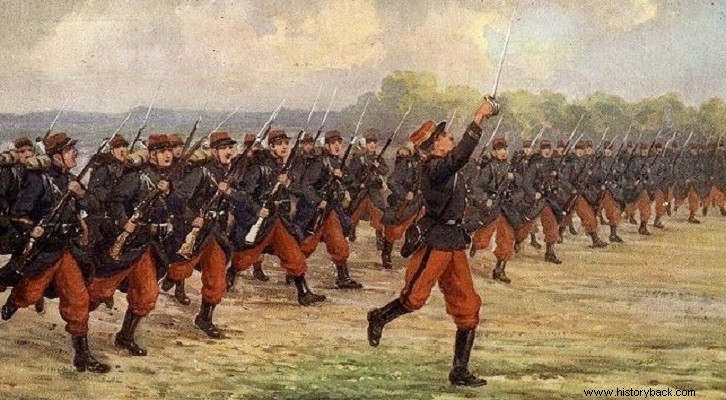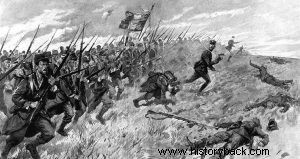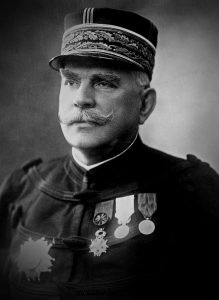
After the defeat of 1870-71 France devoted herself to recovering the lost provinces of Alsace and Lorraine. Politicians, people and the army devoted all their thought and energy to this. The French Army drew up all its plans for a future war with Germany on this prospect. Based on these plans, with the outbreak of the First World War, he attempted to achieve exactly this goal, essentially ignoring the enemy's reactions.
In 1870-71 France suffered one of the most humiliating defeats in its history. The Prussian and their allied German armies reached Paris. Destroyed France was forced to hand over the provinces of Alsace and Lorraine which Germany, not so unfairly, historically, considered German. Since then the French Army began to plan their recovery.
Based on the French designs it was the infamous Design XVII. This plan began to be drawn up in 1911 and was the inspiration of the newly appointed French commander-in-chief General Joseph Zoffre and his staff. The plan was completed and officially approved in 1913. Unlike earlier French plans, Plan XVII did not seriously consider the possibility of a German attack westward through Belgian territory.
Plan XVII
Joffre's exclusive thought was the attack, in general and the attack to recover Alsace and Lorraine, in particular. Consequently, the French strategic concentration was adjusted accordingly. However the French plan, as it turned out in practice, was based on completely incorrect information about the German concentration.
The intelligence service of the French Army, for many years supported the possibility that Germany would not respect the neutrality of Belgium and would want to take advantage of the direction through this country, in order to overwhelm the left flank of the French armies. Gradually, this image changed, by the grace of Zoffre.
French agents in Berlin were led to believe that the Germans would, at worst, move through Luxembourg and eastern Belgium, while they would throw the bulk of their forces in the center of the front, leaving only covering forces on their left flank, in Alsace and eastern Lorraine, that is.
In the great German Army trainings of 1909-10, it became clear, however, that the Germans would not be limited to passing through a portion of Belgian territory, but would execute a wide hyperkerotic maneuver disregarding Belgian neutrality.
The French staff correctly assessed the situation, then. However, with the assumption of leadership by Zoffre, everything changed and an unjustified wind of optimism began to prevail. So the French staff, drawing up the infamous Plan XVII, did not take into account the enormous superiority of the Germans in heavy artillery, but also in the speed of mobilization of the German reserves.
Frankly, too, the French staff believed that the German reserve formations were inferior in combat power to the active ones and could only undertake secondary missions. The lessons of the Russo-Japanese War of 1904-05, where the value of the machine gun was proven, were also completely ignored. Mainly the inability of the infantry to charge against an opponent equipped with a sufficient number of machine guns was not appreciated.
All relevant reports that reached the French staff and questioned the logic and consequently the effectiveness of Plan XVII and by extension the value of Zoffre's initiator, were naturally treated negatively and summarily dismissed. In essence, Zoffre formed an image of how the Germans would react and managed to impose it at all levels.
But what did Joffre's rigid plan foresee? Initially, at a strategic level, two French armies would undertake an offensive mission in Alsace and Lorraine. Two more would take over the Ardennes-Luxembourg sector and only one the defense of the French left, on the Franco-Belgian border. Later two other French armies were formed which also took part in the attack on Alsace and Lorraine.
Attack at any cost
The inflexible insistence on said planning, combined with the rejection of information about the German counterparts had the effect of the inferior numerically, in relation to its potential opponent, the French Army, being armed, equipped and supplied, also incorrectly .
The French soldier entered the first great, global, massacre dressed in a Napoleonic-inspired uniform, with blue, uncomfortable, uncomfortable, and red trousers , which made it visible to his opponents from hundreds of meters.
Each soldier carried more than 25 kg of cargo and carried an obsolete rifle, the 8mm Lebel. As for machine guns, they were considered defensive weapons that did not match the offensive spirit of the French Army and so the supply of infantry regiments with them was indulgently insufficient.
At the same time, the rigid, also tactical doctrine of the French Army, prevented the initiative of the commanders of the lower and middle echelons, up to the level of the regiment, but sometimes also at the level of division, corps and army. The good commander, for the French staff, was only the obedient commander.
According to the campaign manual of the French infantry, the objective was "the will to exterminate the enemy with the lance, from the cluster". In this spirit there were commands that forbade their men to even take cover behind terrain features or attempt to dig trenches, ordering the slingshots to be thrown away.
The only order that a commander was "allowed" to give was:"Forward with the lance", regardless of the tactical situation, the presence or absence of reserves, the support or not of artillery and even the distance that separated the French unit from its German rivals.
The attacks so foolishly ordered by Joffre caused the first of a series of bloodbaths the French Army was to suffer during WWI. His losses from Zoffre's "intelligent" plan exceeded 200,000 men, of which 5,000, almost, officers, in the Alsace-Lorraine operations.
It was a real, pointless, centurion, which had no practical effect, nor did it affect the course of the war. It was almost the beginning of the shock to French morale, which culminated after the disastrous Nivelle offensive and brought many French units to a standstill. It was obvious that Zoffre exuded a Napoleonic ideal of greatness, and like the great emperor he could exclaim "do you think I care about the lives of a million men?"
Men were thrown into battle, literally, as fodder for the German machine guns and cannons, as if there had been no advance in war technology since the days of Napoleon. As if there were no practical lessons of the power of modern heavy artillery or massed machine-gun fire,as if the French Army were returning to the days of its massed knightly advances at Crecy, Poitiers, or Agincourt, with the overburdened infantry to they play, now, the role of heavy horsemen who even then, however, had been mowed down by the English longbows.
It seems that some refuse to be taught. Unfortunately, in this case, others paid the price for Zofre's sloppiness with their own blood. Despising the blood of his men, Zofr, until his expulsion, gave only one order:"Attack".
But as one French officer wrote:“At the tactical level German firepower proved our military doctrine to be nonsense. Our morale, all our fantasies dissipated like smoke. Between August 20 and 23 the absolute sense of security we felt turned into a feeling of fear." That officer was Charles de Gaulle.

Napoleonic style attack by French infantry with flags flying against German artillery and machine guns.

Joseph Zoffre.
